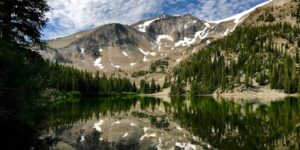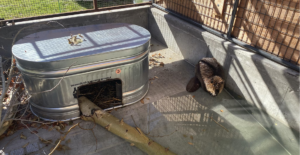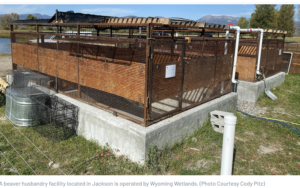Some days it seems like we are racing to keep up with all the good beaver news and some days. well, are more like this: scarred by negative articles in which smart people say stupid things about beavers to a very gullible audience. Brace yourself…
OPINION: Are beavers always the answer? Not really.
 Beavers, through their assiduous dam building, can recharge groundwater and provide habitat for fish and wildlife. In the Pacific Northwest, for example, managers are bringing back beaver as part of trout and salmon management.
Beavers, through their assiduous dam building, can recharge groundwater and provide habitat for fish and wildlife. In the Pacific Northwest, for example, managers are bringing back beaver as part of trout and salmon management.
“God bless beavers and their industrious nature,” writes Trout Unlimited’s Idaho-based Chris Hunt in Hatch magazine. “They make habitat for the fish we love, and opportunities to catch them.” True enough, in Idaho.
But the notion, ubiquitous in America, that all beavers everywhere are a panacea for what ails an ecosystem is misinformed. Yes, beavers are beneficial — in the right places.
For those of you playing along at home you should already be guessing who wrote this article and what comes next. Ted Williams is a revered writer about fly fishing and audubon and all things water. If you search for his name on this website you will find that he has given his opinions on beavers many times before…
Consider the debacle in Nevada. This from Kim Toulouse, the Nevada Department of Wildlife’s former conservation educator: “Historically, virtually every stream in the northern half of Nevada held some form of cutthroat trout. Additionally, many small-order streams also held native redband and bull trout. When the push started (for trout recovery) we discovered that many single-order streams were infested with heavy populations of beavers.
Infested? Great use of objective scientific language there Kim. How do you really feel about beavers? I’m not sure I can tell…
“Extremely high numbers of beaver dams on these systems led to loss of gene flow and precluded the ability of fish to move up and down these systems. Additionally, fish found it difficult to find suitable spawning grounds due to heavy siltation caused by the dams. The loss of riparian habitat led to erosion, more siltation, less shade, higher water temperatures, loss of native riparian vegetation, and establishment of noxious invasive plants.” So Nevada initiated major beaver control. But politicians, incited by the Humane Society of the U.S., shut it down.
Because you know what a crazy strong force THE HUMANE SOCIETY is in NEVADA for god sakes. They practically write the laws. I mean that’s the story we tell ourselves in my state of Massachusetts so Nevada must be exactly the same, right?
Beaver damage to Minnesota and Wisconsin trout streams is even worse. Fisheries managers have to hire Wildlife Services, a federal agency, to trap beavers and blow up dams. It’s expensive, so only a small percentage of streams can be salvaged.
And Trout Unlimited reports that in Minnesota’s Knife River watershed, “artificially high beaver numbers…threaten the survival of coldwater fisheries, as well as the health of the watershed and Lake Superior.” But an outfit ironically called “Advocates for the Knife River Watershed” is fighting to nix beaver control, circulating junk science and such fictions as “beaver have been totally eradicated in the whole Knife River valley — over 200 square miles.”
Oh my goodness. Those crazy beaver lovers are taking over the world. And how exactly are the high numbers of beavers artificial? Are you implying they were introduced?
California’s Silver King Creek watershed is the only refuge for threatened Paiute cutthroat trout, yet overpopulated beavers block migration and destroy habitat. It got so bad in Four-Mile Creek that Trout Unlimited volunteers had to reroute the stream.
If you were to look this up you’d find an article from trout unlimited which says that beavers are NOT NATIVE to the sierras and were INTRODUCED so they blocked all those cutthroat from getting around…NEVER MIND research…
“The biggest problem I see is that beavers move into an area that doesn’t have enough forage, and they abandon their dams,” said retired state fisheries biologist Bill Sommer. “When beavers leave, the dams blow out and that causes erosion.”
You mean the biggest problem is when beavers leave? Is that what you’re saying?
Aldo Leopold could grasp two realities about deer simultaneously. Were he still alive, he’d applaud Phil Monahan, who wrote this in Trout Unlimited’s Trout Magazine: “Many anglers see the beavers’ work as predominately destructive — turning a babbling trout stream into a slow-moving wetland, for instance. Wildlife biologists recognize that each of these ‘destructive’ effects has a flip side: situations in which that very same effect is beneficial to trout.
“After looking at all the data, then, the question, ‘Are beavers good or bad for trout streams?’ can be answered only with a definitive: ‘It depends.’”
It depends? Are you sure you want to leave it so open ended Ted? You haven’t said a single good thing about beavers yet so how exactly does it “Depend”? Of course never mind that deep pools made by the beavers don’t dry up in the summer or freeze in the winter. Just leave all that water business aside. Beavers are bad. You know it and only the supreme power of the humane society makes people like them.
Best part is that this article runs along side a photo of a nutria. Which I believe is fully illustrative of how much Ted Williams understands about this subject.













































